Goodbye 2016, Hello 2017! EFSP starts the New Year with a guest post. Film historian Ivo Blom chose for this New Year's post 12 postcards from his collection which feature mirrors. Ivo: "Mirror, mirror on the wall... Already in Antiquity mirrors had a connotation of magic, a tradition which has maintained – just think of Snow White or Harry Potter’s Mirror of Erised. The use of real mirrors in film has also become an established feature of film language. It developed in the 1910s as a typical European phenomenon in silent cinema, which set cinema apart from theatre."
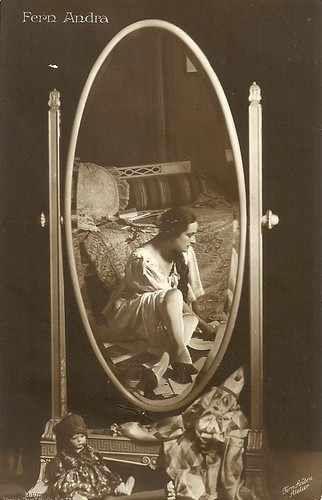
German postcard by Ross Verlag, no. 289/2, 1919-1924. Photo: Fern Andra Atelier.

German postcard by Ross Verlag, no. 289/3, 1919-1924. Photo: Fern Andra Atelier.
'Modern' American actress Fern Andra (1893-1974) became one of the most popular film stars of the German cinema in the 1910s and early 1920s. In her films she mastered tightroping, riding horse without a saddle, driving cars and motorcycles, bobsleighing, and even boxing.
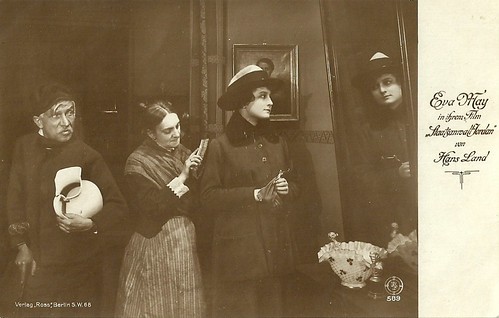
German postcard by Ross Verlag, no. 589, 1919-1924. Photo: Ring-Film. Eva May in Staatsanwalt Jordan (Erik Lund, 1919). The man on the left is Hermann Picha, May is the lady watching herself in the mirror.
Eva May (1902-1924) was the daughter of film star Mia May and producer Joe May. It was only natural that she would follow suit. She became ‘everybody’s darling’ but in 1924 she committed suicide.
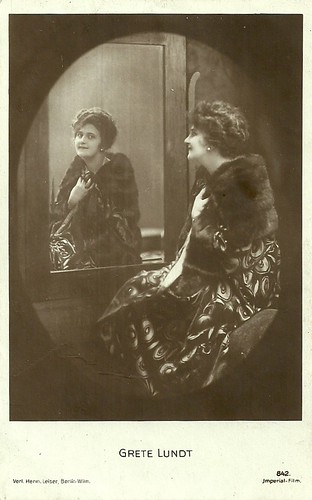
German postcard by Verlag Hermann Leiser, no. 842. Photo: Imperial-Film.
Grete Lundt aka Grete Lund (1892-1926) was as an Austrian stage and screen actress, who played in Austrian and German silent films. Lundt was befriended with Julius Barmat, the Jewish merchant who would be the centre of the Barmat Scandal, which discredited the SDP because of the exposure of wide-spread corruption. It also raised anti-Semitism, and helped the right wing to win the 1925 elections. Lundt’s career went down by lack of work and money, aggravated by a morphine addiction. In order to pay for the costs of a morphine addicts clinic, she had to sell her house and all her belongings. On New Year’s Eve 1926, a desperate Lundt committed suicide in the Vienna-Berlin D-train, using an overdose of morphine. Grete Lundt died 60 years ago.
Mirrors were used for visual dialogues between off-screen and on-screen characters and for the creation of suspense and voyeurism. It then developed both in mainstream and avant-garde cinema, in particular in German cinema of the 1920s and early 1930s, and subsequently in classical Hollywood cinema.
It is part of a wish to prefer a more synthetic approach in cinema, by use of deep staging and lengthy shots over-analytical editing in which acting is cut up over several shots. It is also part of a wish to suggest that the world of cinema does not stop at the borders of its frame, involving the off-screen space and off-screen characters.
Of course, mirrors may be explained in film sets as natural ingredients, even if in constructed interiors. People will dress in front of mirrors, check their face and clothes, comb their hair, shave, use makeup or remove it again. Mirrors also add a dimension to the film space, showing parts that otherwise would remain hidden: the fourth wall.
But mirrors can also be used in a narrative and metaphorical way, such as the introspection, the showing of guilt and desire, passages to other worlds, the calling of the future, or ghosts from the past.

American postcard, monogram K Ltd. Francesca Bertini in Odette (Giuseppe De Liguoro, 1916).
Majestic diva of the Italian silent cinema Francesca Bertini (1892-1985) was one of the first European film stars. During the first quarter of the twentieth century she often played the 'femme fatale', with men devouring eyes, glamorous attire, clenched fists, and in opulent settings, or the suffering 'femme fragile, who is devastated by the adultery of her man.
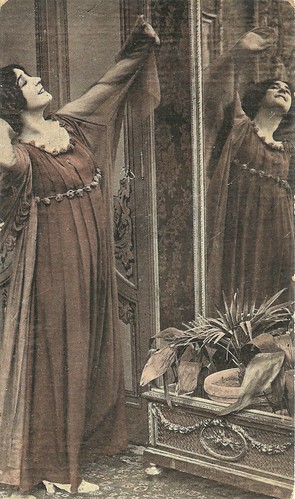
Spanish postcard by Chocolate Salas Sabadell. Leda Gys in Fernanda (Gustavo Serena, 1917), based on Victorien Sardou's play.
Italian film diva Leda Gys (1892-1957) starred in ca. 60 dramas, comedies, action thrillers, and even westerns of the Italian and Spanish silent cinema. Her claim to fame came with the film Christus (1916), shot in Egypt and Palestine, where Gys performed the Madonna.

Italian postcard by Vettori, Bologna, no. 1057. Photo: Zambini, Parma.
Alda Borelli (1879-1964) was an Italian stage and screen actress, who peaked on stage in the 1920s and also acted in a handful of silent films in the 1910s. She was the sister of Italian film diva Lyda Borelli.

German postcard by Ross Verlag, no. 1174/1, 1927-1928. Georges Biscot aka Biscot Meyer.
Georges Biscot (1886-1945) was a popular French music-hall and revue singer and actor, who also knew a career in French silent and sound film.
In postcards with stars of the silent cinema, we mostly encounter the joy of mirroring oneself, as in the postcards with the Italian divas like Francesca Bertini and Leda Gys enjoying their own beauty.
It happens though often with a twist, the so-called Venus-effect, after Diego Velazquez’ portrait called Rokeby Venus. In order to get a perfect reflection of the portrayed person, the mirror is placed obliquely, showing us the reflection of the person at its best. Instead, the person is likely not to see himself or herself but rather the camera, so the onlooker. Also, the mirror is often tilted, to avoid the reflection of the camera.
In the 1920s the French magazine Comoedia released a series of hundreds of postcards of French actors of the stage, called Nos artistes dans leur loges (Our artists in their dressing-rooms). We notice the actors and often also their reflections in the set-up of their dressing-rooms.
The artists are dressed in theatre costumes that often refer to famous plays they were in, and photos attached to the mirrors confirm this. Still, many of these actors had also rich careers in French cinema as well, such as here Maxime Desjardins and Jane Rollette.
One of my favourites is the young Renée Simonot, who did not act in the film but was a famous voice actor in France and at the age of 105 is still alive. You may not recall her right away but she is the mother of Catherine Deneuve.
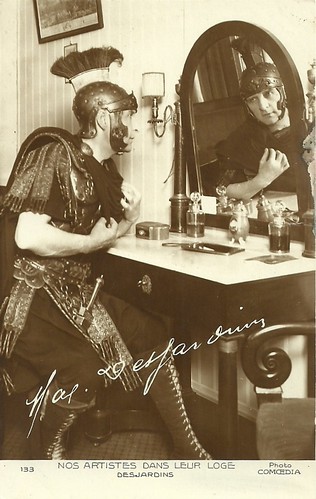
French postcard in the Nos artistes dans leur loge series, no. 133. Photo: Comoedia.
Maxime Desjardins (18961-1936) was a French stage and screen actor, who peaked in the French silent cinema of the 1920s. From 1912 Desjardins acted in cinema, first in short films at Pathé Frères and at Eclair, later in films by acclaimed directors as Abel Gance, Julien Duvivier, and Henri Diamant-Berger.
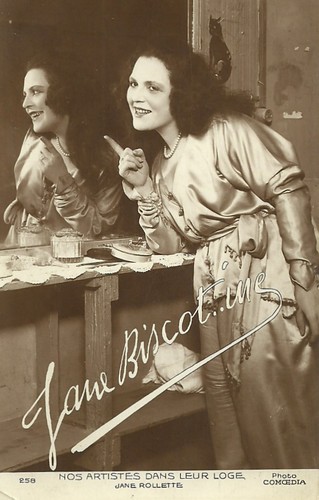
French postcard in the Nos artistes dans leur loge series, no. 258. Photo: Comoedia.
Jane Rollette aka Jeanne Rollette (1891-1994) was a French film actress who peaked in Louis Feuillade's serial films of the late 1910s and early 1920s. In Barrabas (Louis Feuillade, 1919) Georges Biscot played Biscotin, while Rollette played Biscotine.
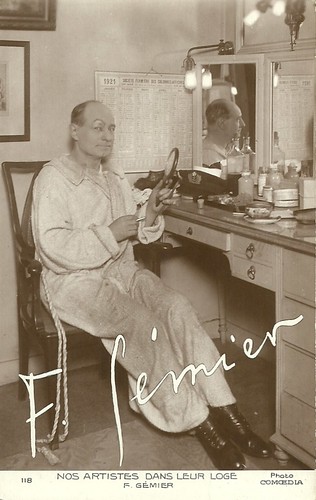
French postcard in the Nos artistes dans leur loge series, no. 118. Photo: Comoedia.
Firmin Gémier (1869-1933) was actor, director, and theatre manager at the French stage, promotor of the Théâtre Populaire, and founder of the first Théâtre National Populaire in Paris in 1920. He also acted in French silent and sound cinema of the 1910s to the 1930s.

French postcard in the Nos artistes dans leur loge series, no. 25. Photo: Comoedia.
Renée-Jeanne Simonot (born 1911) is a French stage actress. Simonot was one of the first French actresses to begin the dubbing of American films in France from the beginning of the talkies in 1929 through the 1930s. She was married to actor Maurice Dorléac, and is the mother of actresses Catherine Deneuve and Françoise Dorléac, and grandmother of actors Christian Vadim and Chiara Mastroianni.
Ivo, thank you very much!

German postcard by Ross Verlag, no. 289/2, 1919-1924. Photo: Fern Andra Atelier.

German postcard by Ross Verlag, no. 289/3, 1919-1924. Photo: Fern Andra Atelier.
'Modern' American actress Fern Andra (1893-1974) became one of the most popular film stars of the German cinema in the 1910s and early 1920s. In her films she mastered tightroping, riding horse without a saddle, driving cars and motorcycles, bobsleighing, and even boxing.

German postcard by Ross Verlag, no. 589, 1919-1924. Photo: Ring-Film. Eva May in Staatsanwalt Jordan (Erik Lund, 1919). The man on the left is Hermann Picha, May is the lady watching herself in the mirror.
Eva May (1902-1924) was the daughter of film star Mia May and producer Joe May. It was only natural that she would follow suit. She became ‘everybody’s darling’ but in 1924 she committed suicide.

German postcard by Verlag Hermann Leiser, no. 842. Photo: Imperial-Film.
Grete Lundt aka Grete Lund (1892-1926) was as an Austrian stage and screen actress, who played in Austrian and German silent films. Lundt was befriended with Julius Barmat, the Jewish merchant who would be the centre of the Barmat Scandal, which discredited the SDP because of the exposure of wide-spread corruption. It also raised anti-Semitism, and helped the right wing to win the 1925 elections. Lundt’s career went down by lack of work and money, aggravated by a morphine addiction. In order to pay for the costs of a morphine addicts clinic, she had to sell her house and all her belongings. On New Year’s Eve 1926, a desperate Lundt committed suicide in the Vienna-Berlin D-train, using an overdose of morphine. Grete Lundt died 60 years ago.
To create suspense and voyeurism
Mirrors were used for visual dialogues between off-screen and on-screen characters and for the creation of suspense and voyeurism. It then developed both in mainstream and avant-garde cinema, in particular in German cinema of the 1920s and early 1930s, and subsequently in classical Hollywood cinema.
It is part of a wish to prefer a more synthetic approach in cinema, by use of deep staging and lengthy shots over-analytical editing in which acting is cut up over several shots. It is also part of a wish to suggest that the world of cinema does not stop at the borders of its frame, involving the off-screen space and off-screen characters.
Of course, mirrors may be explained in film sets as natural ingredients, even if in constructed interiors. People will dress in front of mirrors, check their face and clothes, comb their hair, shave, use makeup or remove it again. Mirrors also add a dimension to the film space, showing parts that otherwise would remain hidden: the fourth wall.
But mirrors can also be used in a narrative and metaphorical way, such as the introspection, the showing of guilt and desire, passages to other worlds, the calling of the future, or ghosts from the past.

American postcard, monogram K Ltd. Francesca Bertini in Odette (Giuseppe De Liguoro, 1916).
Majestic diva of the Italian silent cinema Francesca Bertini (1892-1985) was one of the first European film stars. During the first quarter of the twentieth century she often played the 'femme fatale', with men devouring eyes, glamorous attire, clenched fists, and in opulent settings, or the suffering 'femme fragile, who is devastated by the adultery of her man.

Spanish postcard by Chocolate Salas Sabadell. Leda Gys in Fernanda (Gustavo Serena, 1917), based on Victorien Sardou's play.
Italian film diva Leda Gys (1892-1957) starred in ca. 60 dramas, comedies, action thrillers, and even westerns of the Italian and Spanish silent cinema. Her claim to fame came with the film Christus (1916), shot in Egypt and Palestine, where Gys performed the Madonna.

Italian postcard by Vettori, Bologna, no. 1057. Photo: Zambini, Parma.
Alda Borelli (1879-1964) was an Italian stage and screen actress, who peaked on stage in the 1920s and also acted in a handful of silent films in the 1910s. She was the sister of Italian film diva Lyda Borelli.

German postcard by Ross Verlag, no. 1174/1, 1927-1928. Georges Biscot aka Biscot Meyer.
Georges Biscot (1886-1945) was a popular French music-hall and revue singer and actor, who also knew a career in French silent and sound film.
The Venus Effect
In postcards with stars of the silent cinema, we mostly encounter the joy of mirroring oneself, as in the postcards with the Italian divas like Francesca Bertini and Leda Gys enjoying their own beauty.
It happens though often with a twist, the so-called Venus-effect, after Diego Velazquez’ portrait called Rokeby Venus. In order to get a perfect reflection of the portrayed person, the mirror is placed obliquely, showing us the reflection of the person at its best. Instead, the person is likely not to see himself or herself but rather the camera, so the onlooker. Also, the mirror is often tilted, to avoid the reflection of the camera.
In the 1920s the French magazine Comoedia released a series of hundreds of postcards of French actors of the stage, called Nos artistes dans leur loges (Our artists in their dressing-rooms). We notice the actors and often also their reflections in the set-up of their dressing-rooms.
The artists are dressed in theatre costumes that often refer to famous plays they were in, and photos attached to the mirrors confirm this. Still, many of these actors had also rich careers in French cinema as well, such as here Maxime Desjardins and Jane Rollette.
One of my favourites is the young Renée Simonot, who did not act in the film but was a famous voice actor in France and at the age of 105 is still alive. You may not recall her right away but she is the mother of Catherine Deneuve.

French postcard in the Nos artistes dans leur loge series, no. 133. Photo: Comoedia.
Maxime Desjardins (18961-1936) was a French stage and screen actor, who peaked in the French silent cinema of the 1920s. From 1912 Desjardins acted in cinema, first in short films at Pathé Frères and at Eclair, later in films by acclaimed directors as Abel Gance, Julien Duvivier, and Henri Diamant-Berger.

French postcard in the Nos artistes dans leur loge series, no. 258. Photo: Comoedia.
Jane Rollette aka Jeanne Rollette (1891-1994) was a French film actress who peaked in Louis Feuillade's serial films of the late 1910s and early 1920s. In Barrabas (Louis Feuillade, 1919) Georges Biscot played Biscotin, while Rollette played Biscotine.

French postcard in the Nos artistes dans leur loge series, no. 118. Photo: Comoedia.
Firmin Gémier (1869-1933) was actor, director, and theatre manager at the French stage, promotor of the Théâtre Populaire, and founder of the first Théâtre National Populaire in Paris in 1920. He also acted in French silent and sound cinema of the 1910s to the 1930s.

French postcard in the Nos artistes dans leur loge series, no. 25. Photo: Comoedia.
Renée-Jeanne Simonot (born 1911) is a French stage actress. Simonot was one of the first French actresses to begin the dubbing of American films in France from the beginning of the talkies in 1929 through the 1930s. She was married to actor Maurice Dorléac, and is the mother of actresses Catherine Deneuve and Françoise Dorléac, and grandmother of actors Christian Vadim and Chiara Mastroianni.
Ivo, thank you very much!
No comments:
Post a Comment